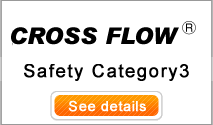Why Use Double Valve?
Adouble valve is designed to promote safety in the operation of many pneumatically controlled machines, and satisfy regulatory requirements for valves used on mechanical power presses employing pneumatically controlled clutch and breake mechanisms.
A ROSS double valve has two valve elements independently controlled by two solenoid pilot valves. The two valve elements share common inlet, outlet, and exhaust ports. When the pilot valves are operated simultaneously so that during normal operation the valve functions like a three-way valve with a single element.
If one of the valve elements does not open or close in sync with the other, the valve is designed to keep the pressure on the ourlet port at less than two percent of the inlet pressure. This is an inherent safety characteristic of ROSS' double valve design. Valve element redundancy provides a safety factor as the likelihood of both valve elements malfunctioning on the same cycle is considered extremely remote.
IMPORTANT NOTE: Amechanical power press or other hazardous machines using a pneumatically-controlled clutch and brake mechanism should use a double valve with a self-contained monitoring device and/or external monitoring system ehidh inhibits further operation of the valve and machine valve is just one of the components in a press control system, and all other elements of the system should be planned with safety as primary consideration.
SERPAR ® Crossflow Double Valves
The design of the SERPAR(R) Crossflow double valve is distinguished by crossflow passages and spool valving on the main valve stems. This arrangement provides the valve's unique flow characteristics.
| VALVE SIZES |
|---|
| ROSS double valves are now available in six sizes, providing a full range of sizes to meet your needs. For convenience, valves are designated by the nominal sizes 1,2,4,8,12, and 30. These sizes approximate an average of the flow coefficients (Cv) of the various flow paths through the valve. Further information about (Cv) ratings is given on page 18. |
| MONITORS |
| Self-contained monitors, designed to inhibit valve operation in case of a fault within the valve, are built into the valve assemblies of size 4,8,12, and 30 valves. There are three types of ROSS monitors available: pneumatic(L-G), electro-pneumatic(E-P), and electronic(D-S). |
| PRESSURE SWITCHES |
| Size 1 and 2 valves are available with pressure switches for incorporation into press control systems with external monitors. Customers may design their own external monitoring system to work in conjunction with these valves. This option puts complete control in the hands of the customer and lets their external monitoring system make all shut-down/lock-out decisions. |
| VALVE ELEMENT CONSTRUCTION |
| The dual valve elements are of lightweight construction. Their low inertia allows them to respond quickly to actuating and desctuating forces. Impact loads are also kept small to help assure long valve life. Each valve element is guided at the top by the piston and at the bottom by the stainless steel stem, and there is no sliding bearing surface between. |
| The Leade in Double Valve Design |  |
|---|---|
| ROSS has long been in the forefront of double valve research and development. For over 45, years ROSS has been responding to the needs of press manufacturers by developing and suppling double valves of different types. Intemal flow pattems have included series flow, parallel flow, and combined series flow. Monitoring devices have also been offered in a variety of designs to satisfy differing requirements. The manifestation of all this experience is seen in the present line of SERPAR(R) Crossflow double valves described in this brochure. Selecting the double valve best suited to each application requires considerable technical knpwledge. If you need information or application assistance, please consult ROSS (see back cover). |

alve Assembly

* Model number includes base. For G threads, order with a “D” prefix. For JIS threads, order with a “J” prefix. Valve and base can be ordered separately; consult ROSS.
** Only valves with pressure switches should be used to control clutch/brake mechanisms on press machinery .The pressure switches must be used in conjunction with a monitoring device to assist with OSHA comp;iance (Ref. 1910.217).
Valve Response Time
These constants, designated M & F, can be used to determine the amount of time required to fill or exhaust a volume of any size using the following formula:
Vlv. Resp. Time(msec)=M+(F V)
M= avg.time for parts movement
F= msec. per cubic inch of volume
V= volume in cubic inches

Pressure Switches & Monitoring:
Valves without pressure switches must not be used to control clutdh/brake mechanisms on press machinery. Valves with pressure switches must be used in conjuction with an external monitoring device to assist with OSHA compliance (Ref. 1910.217). The valves on this page do not have a built-in monitor, and so must only be used in conjuction with an external monitoring system.Such monitoring system must be capable of inhibiting the operation of the valve and associated machinery in the event of a failure within the valve.
IMPORTANT NOTE please read carefully and thoroughly all of the CAUTIONS on page 87.
STANDARD SPECIFICATIONS:
Pilot Solenoids: Two, rated for continuous duty.
Standard Voltages: 100-110 volts 50 Hz; 100-120 volts 60 Hz; 24, 110 volts d.c. Other voltages available.
Power Consumption: Size 1: Each solenoid, 12 VA maximum inrush, 9.8 VA maximum holding on 50 or 60 Hz; 7.5 watts nominal on d.c. Size 2: Each solenoid, 11 VA macimum inrush, 8.5 VA maximum holding on 50 or 60 Hz; 6 watts maximum on d.c.
Electrical Connections:
Uses two cord-grip connectors at solenoids (order separately). Size 2 connectors, see page 31. Size 1 Connectors: (specify solenoid voltage for options with light)
For use with dropcord (cord not included)・・・・・266K77 (w/o light)
267K77 (w/light)
Wired with 10-mm cord (cord exits upward)・・・372K77 (w/o light)
382K77 (w/light)
Other options available; consult ROSS.
Ambient Temperature: 40°to 120°F (4°to 50℃).
Media Temperature: 40°to 175°F (4°to 80℃).
Flow Media: Filtered air. 5 micron recommended.
Inlet Pressure: 40 to 100 psig (2.8 to 7 bar).










